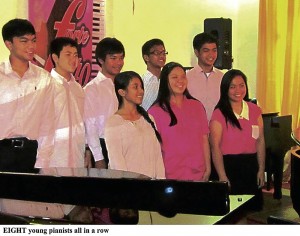
Eons ago, when we were living in Malate, Manila, having been unceremoniously uprooted from war-torn Ermita, my mother made my sister and I take up the piano. Our teacher was a friend of the family, a mestiza called Ms Barros, whom we called Tita Nena.
Her favorite piece was “Malagueña,” and when she attacked the ivory keys it seemed to us kids that this was the most formidable and difficult composition in the world.
I didn’t really enjoy the lessons, although Ms Barros said I had an ear for music, and I was glad when these stopped. Later, when I learned to love classical music, I regretted I did not continue with my piano lessons.
That sense of regret, stronger than ever, returned as I listened to so many young pianists—in pairs, cuatro manos, sextets, even octets—performing competently for the delectation of the audience at a recent press conference at the Lyric Hall in San Juan City, Metro Manila.
The press con was called to announce “Forte@40,” a grand concert to celebrate the 40th anniversary of the Piano Teachers Guild of the Philippines (PTGP-askptgp@yahoo.com). This will be held at the Cultural Center of the Philippines on Nov. 18, 3 p.m. and 7 p.m.
A sneak preview of the concert will be held at Lucky Chinatown (Reina Regente St., Binondo, Manila) on Nov. 11, 4 p.m.
Musical multitude
The PTGP was founded on Nov. 2, 1972, by a group of piano teachers led by Lucrecia Kasilag (later National Artist for Music). Their main objective was to uplift teaching and performance standards among their students.
Since then, the guild has enabled top pianists to participate in international music festivals held in Europe, the United States and recently in Malaysia, Vietnam, Thailand and Singapore.
PTGP membership now stands at 525, and includes prominent musical artists such as Fr. Manuel Maramba, OSB; Sr. Mary Placid Abejo, Jovianney Emmanuel Cruz.
Among the speakers at the press con were Anthony Say, PTGP president; Mary Ann Espino, noted pianist and PTGP vice president; and concert pianist Raul Sunico, CCP president and dean of the University of Santo Tomas Conservatory of Music.
Drumbeaters for the concert—“a musical multitude never before heard” (at least in the Philippines)—were justified in their praise. For the concert will feature 40 pianos—10 grand pianos and 30 upright pianos—and over 300 pianists aged 8-80. They will not all be playing at the same time, of course.
Musical genres
Five genres of music will be represented: Baroque, classical, 20th-century, pop and Filipino. And many big-name concert pianists will participate. The conductors are Hermenigildo Ramera and Daniel Bartolome.
Transcribed symphonies by Mozart and Haydn will have 10 pianos and 10 players, and 40 pianos and 40 players, respectively. The “Harry Potter” Fantasy by Kabaitan Bautista (a young composer who performed during the press launch) will have 30 pianos, 30 pianists, with one per piano.
There will be a polonaise by Chopin; a concertino on familiar tunes; and a pop medley arranged by Ryan Cayabyab.
The piece-de-resistance will be “Mga Gintong Pamana” (Golden Heritage) by Augusto Espino, which, as noted by Say during the press con, is “the finale and the most complex work [of the evening] as it is a compilation of Filipino works that were handed down to the succeeding generation and which we will be handling down to the next generation.”
A scene-stealer that day was precocious Hansel Ang, age 9. He said he took up the piano “because my father knows only the piano.”
His favorite composer is Haydn; whereupon he astounded everyone by interpreting Kachaturian’s difficult Fire Dance. Awesome.
A future (male) Cecile Licad coming up?